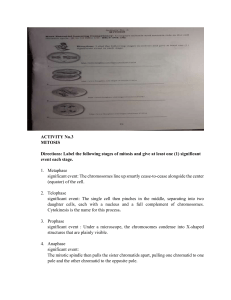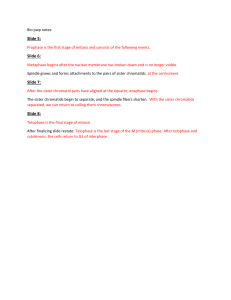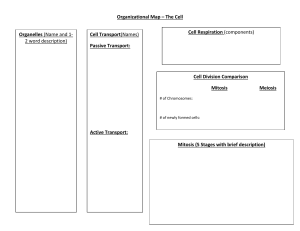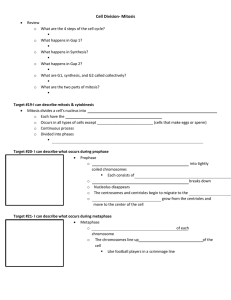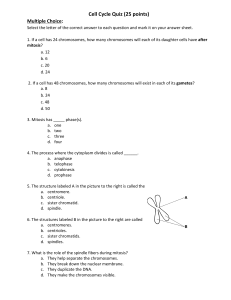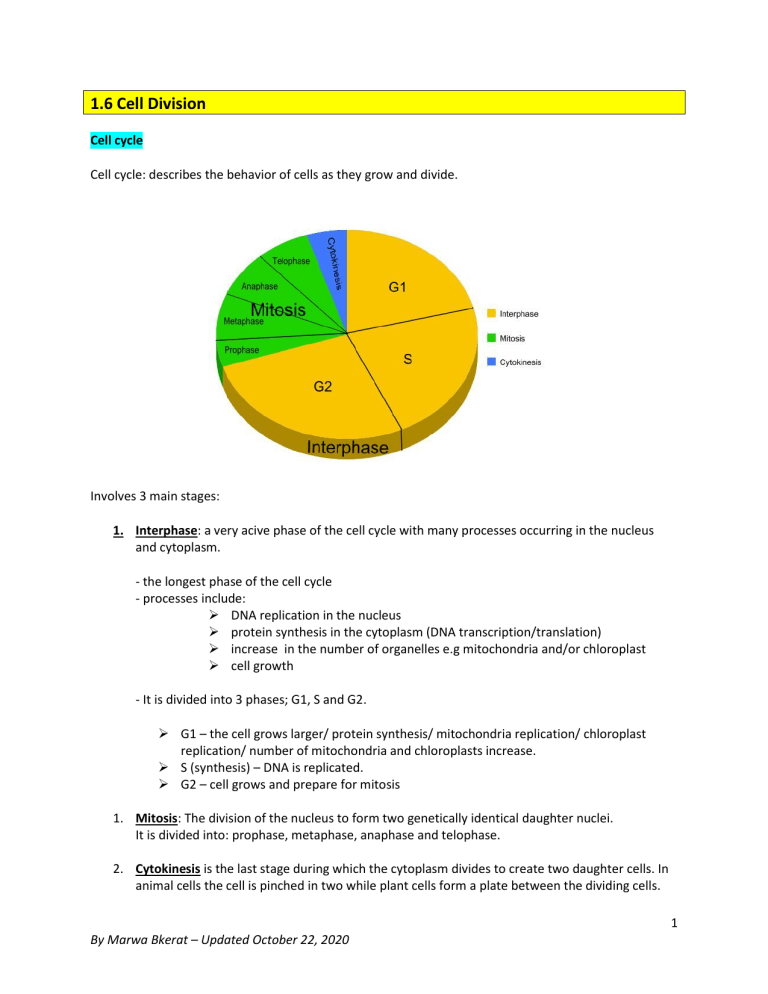
1.6 Cell Division Cell cycle Cell cycle: describes the behavior of cells as they grow and divide. Involves 3 main stages: 1. Interphase: a very acive phase of the cell cycle with many processes occurring in the nucleus and cytoplasm. - the longest phase of the cell cycle - processes include: ➢ DNA replication in the nucleus ➢ protein synthesis in the cytoplasm (DNA transcription/translation) ➢ increase in the number of organelles e.g mitochondria and/or chloroplast ➢ cell growth - It is divided into 3 phases; G1, S and G2. ➢ G1 – the cell grows larger/ protein synthesis/ mitochondria replication/ chloroplast replication/ number of mitochondria and chloroplasts increase. ➢ S (synthesis) – DNA is replicated. ➢ G2 – cell grows and prepare for mitosis 1. Mitosis: The division of the nucleus to form two genetically identical daughter nuclei. It is divided into: prophase, metaphase, anaphase and telophase. 2. Cytokinesis is the last stage during which the cytoplasm divides to create two daughter cells. In animal cells the cell is pinched in two while plant cells form a plate between the dividing cells. 1 By Marwa Bkerat – Updated October 22, 2020 Supercoiling of chromosomes DNA wraps around histones → nucleosomes →further wrapped on top of each other → chromatin → more coiling → chromosomes • • • • • During the S-phase, DNA is copied Chromosomes condense by a process called supercoiling The two copies of each chromosome are held together by a protein structure called a centromere. Each chromosome in this state is represented by a pair of sister chromatids. Sister chromatids are two identical DNA molecules held together by centromere. Mitosis - The division of the nucleus to form two genetically identical daughter nuclei. It is divided into: prophase, metaphase, anaphase and telophase. Mitosis involves the following processes: 1. 2. 3. 4. Growth embryonic development tissue repair asexual reproduction 2 By Marwa Bkerat – Updated October 22, 2020 Phases of mitosis Phase 1. Prophase • • • • 2. Metaphase • • • 3. Anaphase • • • 4. Telophase • • • • Event The spindle microtubules start growing and start to extend from each pole to the equator. Sister chromatids condense by supercoiling. Sister chromatids thicken, shorten and become visible. The nuclear envelope starts breaking down The sister chromatids move to the equator and line up separately. The spindle microtubules from each pole attach to each centromere on opposite sides. The spindle microtubules are fully developed the spindle microtubules contract to pull the sister chromatids apart splitting the centromeres. This splits the sister chromatids into chromosomes. Each identical chromosome is pulled to opposite poles. the spindle microtubules break down the chromosomes uncoil/decondense and so are no longer individually visible. The nuclear membrane reforms. The cell then divides by cytokinesis to form two daughter cells with identical genetic nuclei. To avoid confusion in terminology, use the following: - Early stages of mitosis – sister chromatids - From anaphase onwards – chromosomes. By Marwa Bkerat – Updated October 22, 2020 3 Identification of phases of mitosis in cells viewed with a microscope or in a micrograph. interphase prophase metaphase anaphase telophase The Mitotic index Mitotic index = number of cells in mitiosis (counted in the micrograph) Total number of cells The mitotic index is an important prognostic tool for predicting the response of cancer cells to chemotherapy. Cytokinesis: Occurs after mitosis and is different in plant and animal cells. Plant cell Mitosis Cytokinesis No centrioles The cell wall forms a plate between the dividing cells. Animal cell Centrioles are present The cell is pinched in two forming a cleavage furrow. Cyclins and the control of the cell cycle Cyclins: • • • • • • a group of proteins ensure that the tasks of every phase are performed at the correct time so that the cell can move on to the next stage. control of the cell cycle bind to enzymes called cyclin-dependent kinases. These kinases become active and attach phosphate groups to other proteins in the cell. The attachment of phosphate triggers the other proteins to become active and carry out tasks specific to one of the phases of the cell cycle. CDK (inactive) + specific cyclin → active → phosphorylate other proteins (adds P) → proteins become active → carry out specific tasks 4 By Marwa Bkerat – Updated October 22, 2020 • There are 4 main types of cyclins in human cells: ➢ Cyclin D – triggers cells to move from G0 to G1, and from G1 to S phase ➢ Cyclin E – prepares the cell for DNA replication in S phase ➢ Cyclin A – activates DNA replication inside the nucleus in S phase ➢ Cyclin B – promotes the assembly of the mitotic spindle and other tasks in the cytoplasm to prepare for mitosis. Tumor formation and cancer Mutagens, oncogenes and metastasis are involved in the development of primary and secondary tumors. Tumors: - are the results of uncontrolled cell division - Occur in any organ or tissue. - Could be of two types: 1. Primary tumors: when cells adhere to each other and don’t invade nearby tissue. These tumors are unlikely to cause any harm and are classified as benign. 2. Secondary tumors: when tumor cells become detached, move elsewhere in the body (metastasis) and develop into secondary tumours. These tumors are very likely lifethreatening and are classified as malignant, known as cancer. - Agents that cause cancer are known as carcinogens. - Carcinogens may include: ➢ Mutagens: agents that cause gene mutations, which can cause cancer. ➢ Some viruses ➢ High energy radiation such as X-rays and short-wave ultraviolet light. Mutations: random changes to the base sequence of genes. Most genes don’t cause cancer if they mutate. The few genes that cause cancer after mutating are known as oncogenes. In a normal cell, oncogenes are involved in the control of the cell cycle and cell division. This is why mutations in them can cause tumor formation. 5 By Marwa Bkerat – Updated October 22, 2020 Metastasis: the movement of cells from a primary tumor to set up secondary tumors in other parts of the body. Smoking and cancer • • • There is a strong positive correlation between cigarette smoking the death rate due to cancer (incidence of cancers). Surveys have shown that the more cigarettes that one smokes per day, the higher the death rate due to cancer. The main cancers involved are cancer of the mouth, pharynx, larynx, esophagus and lungs 6 By Marwa Bkerat – Updated October 22, 2020
